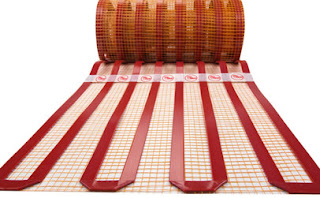What To Get For Your Home – Choose Radiant Floor Heating
Whether you opt for a hydronic or electric system, the benefits of this heating method are hard to ignore: unparalleled comfort, energy efficiency, space-saving, and improved indoor air quality. If you are looking to upgrade your home's heating system and enhance your overall quality of life, consider the warm embrace of under floor heating.
 |
| Radiant floor heating |
Installation Methods
The method of installation
depends on the type of heated floor system:
- Hydronic In-Floor Heating:
- PEX (cross-linked polyethylene) tubing is
installed within a concrete slab, thin concrete overlay, or under the
subfloor.
- Installation can be more complex and typically
requires professional help.
- The tubing is connected to a heat source, and the
system is controlled by a thermostat.
- Electric Radiant Heating:
- Electric heating mats or cables are embedded in
thin-set mortar or self-leveling compound directly beneath the floor
covering.
- These systems are often DIY-friendly, but
professional installation of the radiant floor heating is recommended for larger
projects.
- A thermostat controls the electric system,
allowing you to set your desired temperature.
Benefits of In-Floor Heating
- Comfort: Heated floors offer even,
consistent warmth, eliminating cold spots and drafts in your home. The
feeling of stepping onto a warm floor on a cold morning is nothing short
of luxurious.
- Energy Efficiency: Radiant floor heating is
energy-efficient. Hydronic systems can be powered by renewable energy
sources, while electric systems can be controlled room-by-room, reducing
energy consumption.
- Space Saving: Unlike bulky radiators or
ducts, in-floor heating is hidden beneath your floor, saving space, and
enhancing the aesthetics of your living space.
- Allergen Reduction: In-floor heating and floor heating mat reduces the circulation of dust and allergens that are
common with forced-air systems, contributing to better indoor air quality.
- Silent Operation: Radiant floor heating
operates silently, without the noise associated with traditional heating
systems.


Comments
Post a Comment